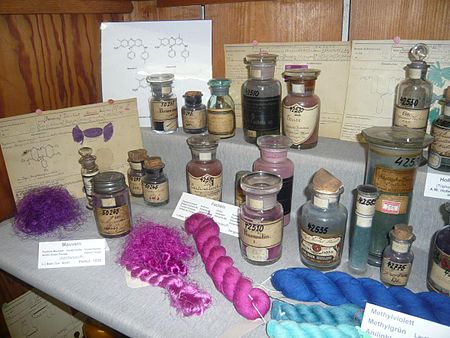Tar colors

As tar colors or tar dyes (also aniline dyes ) were originally made of constituents of coal tar (z. B. aniline ) synthetic organic dyes respectively. The term was often used in a broader sense for all synthetic dyes .
history
Friedlieb Ferdinand Runge dealt with the technical utilization of coal tar around 1830 . Among other things, he isolated and characterized aniline and developed the Runge chlorinated lime reaction as evidence of aniline . In this case, traces of aniline are indicated by an intense red-violet color when mixed with chlorinated lime solution . After further work by August Wilhelm von Hofmann , the first synthetic dye was produced in 1856 by Hofmann's student William Henry Perkin . Perkin patented the purple dye mauvein , which was suitable for dyeing silk, and founded Great Britain's first tar dye factory in Greenford Green near London , where mauvein was produced as early as 1857. In the years that followed, the chemistry of tar paints developed rapidly and led to the establishment of many new production facilities. Important manufacturers were the tar paint factory Oehler in Offenbach (founded in 1842 as a factory for tar distillation), the tar paint factory Meister, Lucius & Co. in Frankfurt (1863), chemical factory Kalle & Co. in Biebrich (1863), chemical factory Griesheim am Main (1863 ), Friedrich Bayer & Co in Elberfeld (1862) and the Badische Anilin & Sodafabrik in Ludwigshafen (1865).
use
The first large-scale use of tar dyes was to dye silk ; however, they were soon used to dye other natural fibers such as cotton and wool . Non-textile applications such as B. paper coloring or food coloring followed. One of the oldest tar dyes, crystal violet (invented by Charles Lauth , 1861), is still used today in Gram staining .
literature
- K. Cura: Colorful world made of stinking mass - From the discovery of tar dyes to the chemical industry . In: Practice of Natural Sciences - Chemistry . tape 60 , no. 6 . Aulis Verlag, Hallbergmoos 2011, p. 29-32 .
- Tar colors . In: Adolf Beythien, Ernst Dressler (Ed.): Merck's Lexicon of Goods for Trade, Industry and Commerce . 7th edition. Gloeckner Verlag, Leipzig 1920. (Reprint: Manuscriptum, Recklinghausen 1996, ISBN 3-933497-13-2 )
- Paul Friedländer: Advances in tar paint production and related branches of industry: On the basis of the systematically arranged and critical comments on the German Reich patents . tape 7 . Julius Springer, Berlin 1905 ( archive.org ).
- Karl Heumann: The aniline dyes and their manufacture: triphenylmethane dyes . Ed .: Paul Friedländer. tape 1 . Friedrich Vieweg and son, Braunschweig 1888 ( archive.org ).
- Karl Heumann: The aniline dyes and their manufacture: nitro, nitroso dyes, naphthalene derivatives . Ed .: Paul Friedländer. tape 2 . Friedrich Vieweg and son, Braunschweig 1898 ( archive.org ).
- Karl Heumann: The aniline dyes and their manufacture: azo dyes . Ed .: Paul Friedländer. tape 3 . Friedrich Vieweg and son, Braunschweig 1900 ( archive.org ).
- Gustav Schultz: The chemistry of the coal tar with special consideration of the artificial organic colorants . Friedrich Vieweg and Son, Braunschweig 1882 ( PDF, 1105 pages , accessed on November 12, 2018).
Individual evidence
- ↑ Hans Beyer, Wolfgang Walter: Textbook of organic chemistry . 18th edition. S. Hirzel Verlag, Stuttgart 1978, ISBN 3-7776-0342-2 , p. 492 .
- ^ Dan Fagin : Toms River: A Story of Science and Salvation . Bantam Books, New York 2014, ISBN 978-0-345-53861-1 , p. 7.
- ↑ About the Dr. Sell in Offenbach made asphalt roofs. In: Polytechnisches Journal . 99, 1846, pp. 180-184.
- ↑ Ernst Bäumler: The red factory . R. Piper GmbH & Co. KG, Munich 1988, ISBN 3-492-10669-2 .